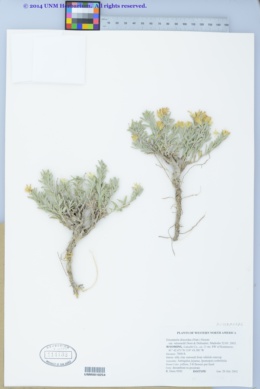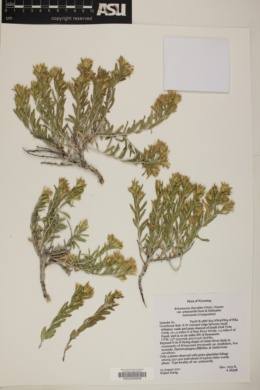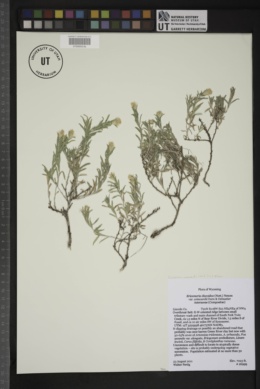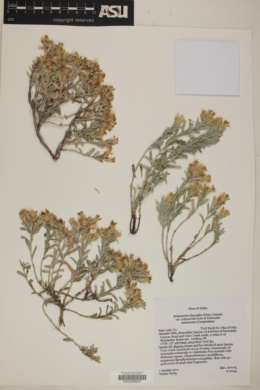Ericameria winwardii
|
|
|
|
Family: Asteraceae
Winward's Heath-Goldenrod, more...Winward's goldenweed
[Ericameria discoidea var. winwardii Dorn & Delmatier] |
Non-technical Description: Winward’s goldenweed is a low-growing shrub with woolly-tomentose stems 5-20 cm tall. Leaves are alternate, narrowly elliptic to oblanceolate, and nearly sessile. Leaf blades are 6-15 mm long, less than 6 times as long as wide, and are covered by white-tomentose hairs (rarely with glandular pubescence and the green surface exposed). Flower heads are borne in short, leafy, terminal cymes and have top-shaped involucres 10-12 mm long x 3-4 mm wide comprised of lance-shaped whitish bracts with short spiny tips. Heads consist of 4-9 yellow disk flowers (ray flowers are lacking), each about 9 mm long with lobes 1-1.5 mm long. The achenes are 5-7 mm long, short-hairy, and topped by a pappus of 40 or more smooth, slightly tawny bristles. Flowering occurs from late July to mid September (Dorn and Delmatier 2005; Fertig 2012). Similar Species: Ericameria discoidea var. linearis has leaves mostly 6 or more times longer than wide, with blades 1-2.5 mm wide and is a taller shrub. Ericameria (Chrysothamnus) parryi var. howardiihas smaller and more numerous flower heads and involucre bracts with needle-like tips arranged in vertical rows. Tetradymia canescenshas non-glandular, white-woolly stems and leaves (Dorn 2001; Dorn and Delmatier 2005; Fertig 2012). Habitat: In Wyoming, populations are known from barren, north-facing exposures of fine, whitish-gray clay of the Fossil Butte member of the Green River shale. Sites typically have 20% or less rock cover and 15-25% vegetative cover of cushion plants and bunchgrasses within openings in denser Artemisia arbuscula-Krascheninnikovia lanata shrublands at 7000-7050 feet (Fertig 2012). Idaho populations are in cushion plant communities on gently dipping slopes and low knolls of the Twin Creek limestone at 6700-7000 feet (Kinter 2009). References: Dorn, R.D and C.H. Delmatier 2005. A new variety of Ericameria discoidea (Asteraceae) from Idaho and Wyoming. Madrono 52:63-65. Fertig, W. 2012. Status of Winward's goldenweed (Ericameria discoidea var. winwardii) in Wyoming. Moenave Botanical Consulting, Kanab, UT. 32 pp.Kinter, C.L. 2009. Survey for Winward’s goldenbush (Ericameria discoidea var. winwardii) on the Caribou-Targhee National Forest, Bear Lake County, Idaho. Idaho Natural Heritage Program, Idaho Department of Fish and Game, Boise, ID. 31 pp. Author: Walter Fertig, Moenave Botanical Consulting, Kanab, UT. April 2017 Plants 5-20 cm. Stems stems prostrate or ascending to erect, green when young (± concealed by tomentum), becoming tan to brown, moderately branched, densely floccose-tomentose, eglandular. Leaves ascending; blades elliptic or oblanceolate (flat), 6-15 × 2.5-5 mm, midnerves prominent, apices acute (often curved downward), faces densely silvery white floccose-tomentose, eglandular; fascicles absent. Heads usually borne singly, sometimes (2-3) in racemiform arrays (5-20 mm wide). Peduncles 1-5 mm (tomentose, bracts 0-3, phyllary-like). Involucres obconic, 9-12 × 3-4 mm. Phyllaries 11-15 in 2-3 series, lanceolate or elliptic to oblanceolate, 1.5-5 × 0.8-1.3 mm, subequal, outer herbaceous or herbaceous-tipped, inner mostly chartaceous or herbaceous-tipped, midnerves conspicuous, raised, (margins: outer herbaceous, entire, floccose-tomentose, inner narrowly scarious, minutely lacerate) apices acute to acuminate, outer abaxial faces floccose-tomentose, inner glabrate. Ray florets 0. Disc florets 4-9; corollas ca. 9 mm. Cypselae tan to brown, narrowly oblanceoloid, 5-7 mm (5-ribbed), densely sericeous; pappi tan, 8-9 mm. Flowering late summer-fall. Silty-clay and clay-shale slopes; of conservation concern; 2000-2200 m; Idaho, Wyo. |





























